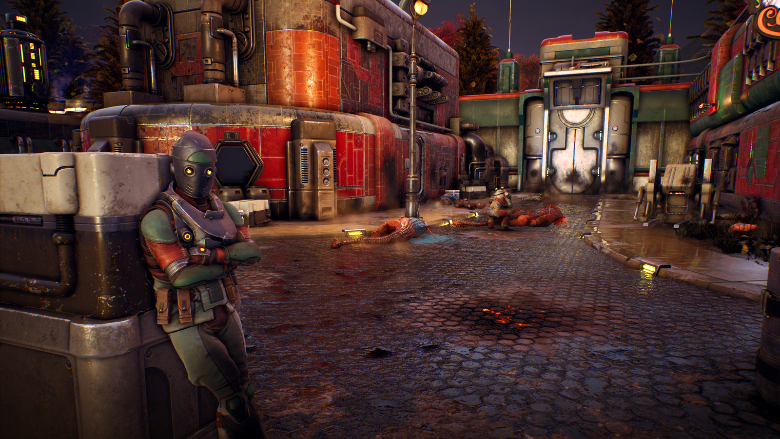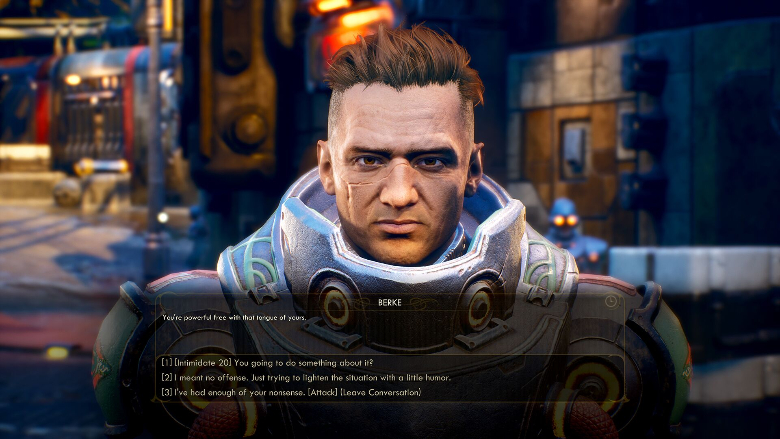
Game: The Outer Worlds
Consoles: Xbox One, PS4 (Reviewed), PC, Nintendo Switch
Publisher: Obisidian Entertainment
Developer: Private Division
(A review copy of The Outer Worlds was supplied by the publisher)
On paper, The Outer Worlds sounds like the weird, kooky cousin of the Fallout franchise. It’s clear that developer Obisidian Entertainment has taken some inspiration from a series they’re so deeply familiar with. From various factions to wicked space monsters to a slow-mo, precision combat mechanic, it’s quite easy to dismiss this as just a clone of Bethesda’s popular series. Yet, The Outer Worlds is so much more thanks to the terrific world-building, characters, and polished gameplay. Obsidian Entertainment has not only crafted a terrific game but perhaps the best RPG of the year.
Taking place in the outer reaches of space, you play a colonist who was cryogenically frozen and set adrift on a massive spaceship. Awoken by criminal on the run Phineas Welles, you learn that a powerful conglomeration of corporate entities known only as “The Board,” has decided to let your fellow colonists remain permanently frozen. Tasked with freeing those trapped on the ship, you’re free to carve your own path in the universe.
While The Outer Worlds boasts a core story, how it all unfolds is completely up to the player. Throughout the campaign, you’ll be given a variety of different choices that will impact how the characters and world advance. This can be as minuscule as deciding whether to help an NPC or as massive as determining the outcome of a faction war on a planet. Every choice you make impacts the larger world, to the point where to can kill any NPC you come across.

There are no “good or “bad” choices in The Outer Worlds, just various shades of grey. Without a direct morality system, it’s up to the user to determine the best course of action. The severity of your decision will ultimately depend on how you decide to complete a quest or dialogue exchange. Killing everyone in a cult may seem like the easiest method, but then you will lose out on the ability to interact with their vendors or even enter a specific area without being attacked. Inversely, taking the time to complete a companion’s unique quest will award you with extra lore about them and a more positive ending.
Because of this, The Outer Worlds demands multiple playthroughs to see how it all unfolds. It’s possible to complete entire quests by just talking to NPCs or sneaking around, hacking different computers. But, if you’re the kind of ne’er-do-well who wants to shoot everything that moves then you’re given that option. With the exception of a few, very scarce missions I never felt as if the game was forcing me down a single gameplay avenue. My own creativity, desire, and personal build heavily factored into how I approached every mission.
With a roughly 40+ hour campaign, you’ll find yourself traveling all across the universe. This is perhaps the biggest and best shift made from previous Obsidian Entertainment games, as The Outer Worlds doesn’t confine you to a single, large map. Instead, you’ll visit a variety of planets and space stations, each of which ranges in size and design. Some worlds boast multiple locations, each of which is brimming with life and personality. My personal favorite is The Ground Breaker, which is a massive space ship that doubles as a huge market place.

Obsidian Entertainment really flexes their creative muscles here, peppering the world with beautiful, colorful areas for you to explore. Drawing from pulp sci-fi stories, all of the armor and weapons have a sleek, old-school look to them that feels ripped right out of Flash Gordon. That being said, the facial animations are still quite stiff, especially when an NPC is trying to be overly expressive. Despite being saved by the superb writing and voice work, the rigidness of characters is difficult to overlook.
Like numerous other RPGs, you will earn experience as you kill enemies, complete quests, or accomplish specific tasks like lockpicking. Obtaining enough XP will increase your level, which then gives you 10 skill points to dump into any one of the dozens available. Occasionally you’ll gain the ability to select a Perk, which is a special passive ability such as increased carrying capacity, extra damage with specific weapon archetypes, or boosting your companion’s combat effectiveness.
You’re free to mix and match across any skill, so there’s a lot of customization options available. Thankfully, what every skill and perk does is explained, so you’ll never make a truly uninformed choice. Players can also earn “Flaws,” which act as negative modifiers that will reward you a free Perk point. Whether you accept the Flaw or not is entirely up to you, allowing greater control over how you develop your colonists.
Occasionally, negotiations will break down and you’ll have no choice but to respond with a hail of bullets. The Outer Worlds’ combat is generally solid, as the game leans heavily on traditional FPS gameplay. Guns all have a nice heft to them and there’s enough of a variety that everyone will have a favorite. While there are no specific rarities to firearms, many of these weapons have different weapons that are showcased in their damage numbers.

Even though you’ll naturally find better versions of guns as you progress, The Outer Worlds does give you the option to upgrade any weapon’s damage. It’s a nice touch that allows you to keep using a weapon you’ve grown attached too. Additionally, you will need to manage a gun’s condition as you use it. This feature isn’t game-breaking by any means, but it really doesn’t add a lot to the game since the core experience doesn’t include any additional survival elements.
Similar to the Fallout games, players are capable of slowing down time and individually targeting specific limits. Called “Tactical Time Dilation,” this mechanic allows the player to manually aim at the limbs of foes. Different body parts are tied to specific status effects such as crippling or blinding an enemy. Unlike the system it draws inspiration from, Tactical Time Dilation will not aim the gun for you so you have a bit more control over whether the bullet actually connects.
Thankfully, not every campaign mission requires you to shoot something in the face – although that is a running theme. Throughout the campaign, I found myself doing everything from helping someone prepare for a date to repairing a large robot to settling planetary disputes. With a lack of “busy work” quests, The Outer Worlds’ missions feel far more streamlined and deliberate than other RPGs. I do wish there was a better way to find side quest starting points, however. Currently, you more or less just stumble into them by talking to people which can make completing all of them a bit maddening.
The Outer Worlds Takeaways

From the moment my escape pod crash-landed on a mysterious planet I was hooked. The Outer Worlds is a tremendously engaging RPG that offers a superb level of freedom and player agency within the game world. Even with some stiff character animations, shakey traversal systems, and lack of a quest indicator, The Outer Worlds is still a masterclass in how to construct a deep, engrossing story. While its inspirations from the Fallout franchise are unquestionable, Obsidian Entertainment elevates the formula to something much greater.
The Outer Worlds is simply out of this world.